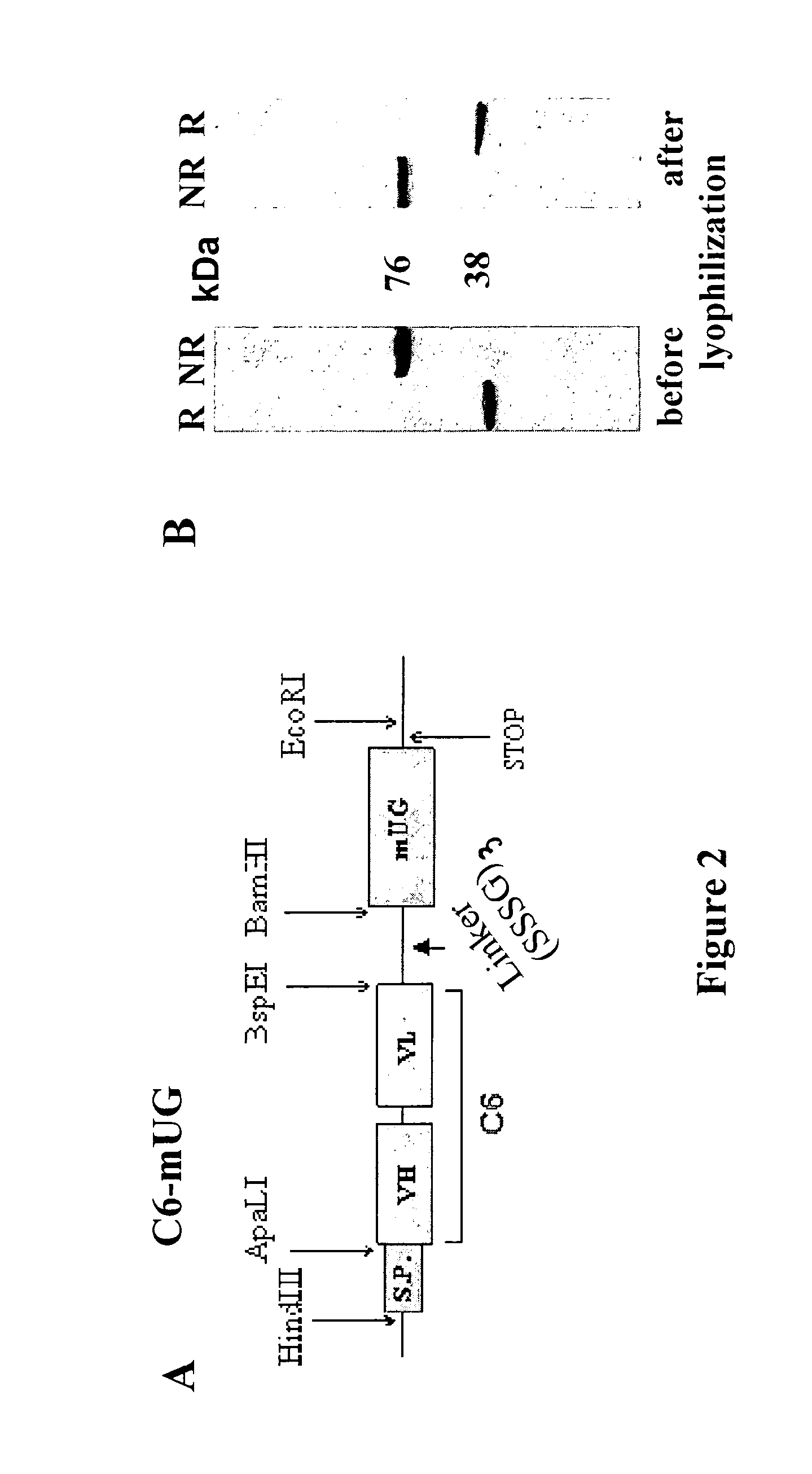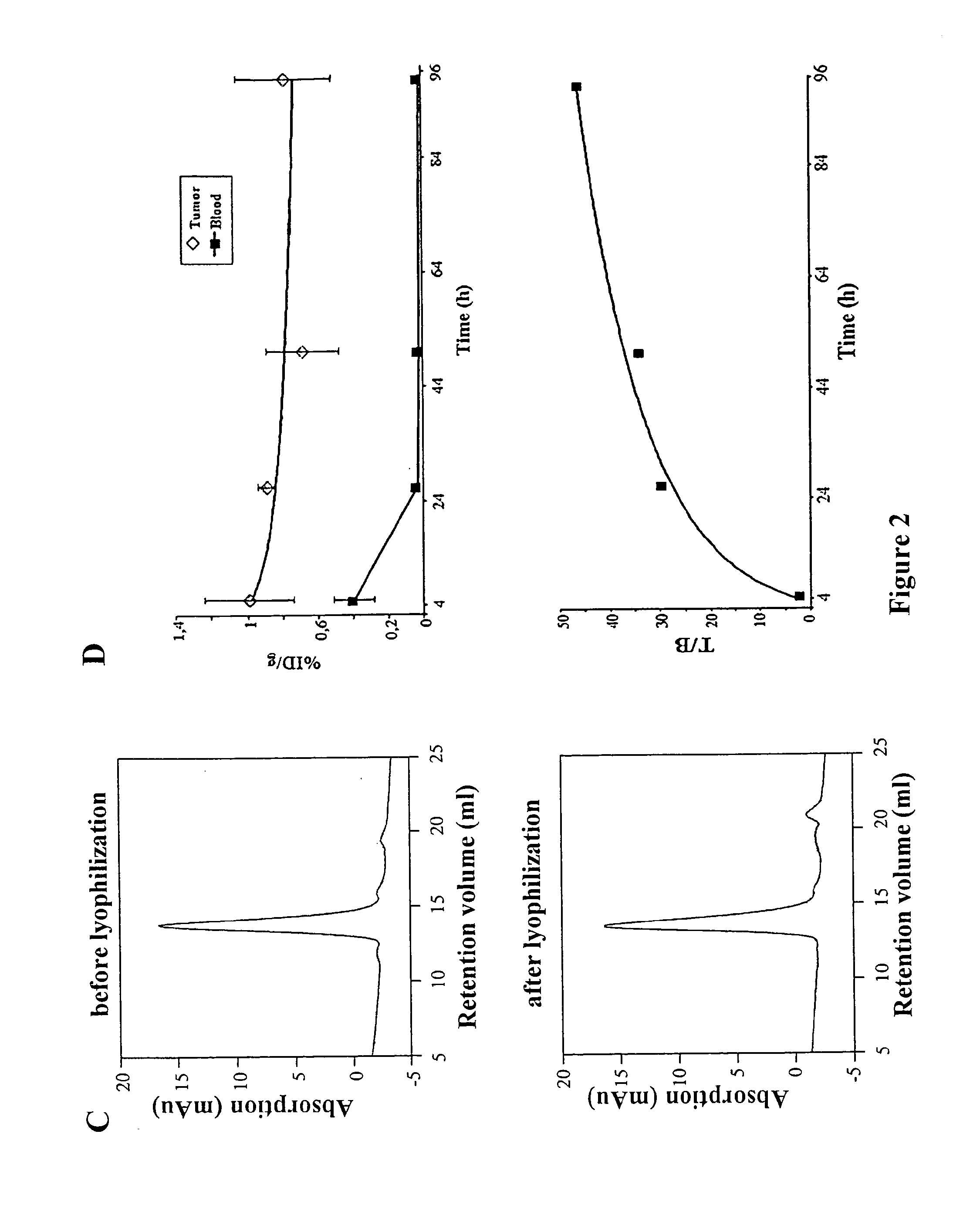Process for engineering polyvalent, polyspecific fusion proteins using uteroglobin as skeleton and so obtained products.
a technology of uteroglobin and fusion protein, which is applied in the direction of immunoglobulins, peptides, lipocortins, etc., can solve the problems of protein instability or inadequate solubility, limiting the production, storage and use of recombinant polyvalent and/or poly-specific fusion proteins as components in novel drugs, and achieving the effect of modifying solubility and stability
- Summary
- Abstract
- Description
- Claims
- Application Information
AI Technical Summary
Benefits of technology
Problems solved by technology
Method used
Image
Examples
example 1
C6-UG
[0043]As is shown in FIGS. 1B and 2A, we prepared cDNA constructs between the scFv C6 and UG by ligating the cDNA of the murine scFv C6 (Balza et al. Submitted) in the 5′ of the UG cDNA in order to produce the divalent C6. FIG. 2 shows the structure of the cDNA construct (A) of C6-UG used to transfect CHO cells that growth in the animal protein-free media ProCHO5 (Lonza, Verviers, Belgium) and produce about 4 mg / liter of recombinant protein that can be efficiently purified by affinity chromatography either using the fibronectin fragment constituted by the type III repeats 7-EDB-8-9 (containing the antigen of C6) or protein A.
[0044]In SDS-PAGE the fusion protein migrates as homodimer in non reducing conditions and as monomer in reducing conditions showing the expected sizes of about 76 and 38 KDa, respectively. In non reducing conditions the molecule was more than 95 percent covalently linked dimer (FIG. 2B). The size exclusion chromatography (SEC) profile showed a single peak w...
example 2
D2E7-UG
[0045]We prepared the cDNA construct encoding for D2E7-UG by ligating the cDNA of D2E7 scFv at the 5′ end of UG cDNA in order to obtain the divalent format of D2E7, as it is shown in FIGS. 1C and 3A. The cDNA construct was used to transfect CHO cells and the fusion protein was purified from the conditioned medium of transfected cells by immunoaffinity chromatography on hTNF-alpha conjugated to sepharose 4B. As is shown in FIG. 3B the purified fusion protein migrates as a homodimer in non-reducing condition with the expected apparent molecular mass of about 72 KDa and as monomer of 36 KDa, in reducing condition. The SEC profile, FIG. 3C, shows a single peak with a retention volume corresponding to the molecular mass of D2E7-UG dimer.
Sequence: D2E7-mUG(SEQ ID No 2)EVQLVESGGGLVQPGRSLRLSCAASGFTFDDYAMHWVRQAPGKGLEWVSAITWNSGHIDYADSVEGRFTISRDNAKNSLYLQMNSLRAEDTAVYYCAKVSYLSTASSLDYWGQGTLVTVSSGDGSSGGSGGASDIQMTQSPSSLSASVGDRVTITCRASQGIRNYLAWYQQKPGKAPKLLIYAASTLQSGVPSRFSGSGSGTDFTLTISSLQPEDVA...
example 3
C6-UG-D2E7
[0046]D2E7 is a human scFv able to inhibit TNF-alpha activity, and is marketed as a complete IgG under the brand name Humira for the treatment of rheumatoid arthritis (RA) and other autoimmune diseases (Tracey et al. 2008). Given that the oncofetal FN isoform containing EDB is over-expressed in RA tissues (Kriegsmann, J. et al. Expression of fibronectin splice variants and oncofetal glycosylated fibronectin in the synovial membranes of patients with rheumatoid arthritis and osteoarthritis. Rheumatol Int 2004. 24 25-33).we generated a dual-specific tetravalent molecule using as a skeleton the UG molecule of and the scFvs C6 (specific for B-FN) and D2E7 (inhibiting TNF-alpha). This molecule offers the possibility to selectively deliver D2E7 to the diseased tissues, thereby achieving an “in situ” inhibition of the TNF-alpha activity. Seeing that UG also is an anti-inflammatory molecule, this fusion protein theoretically constitutes a powerful “in situ” anti-inflammatory drug....
PUM
| Property | Measurement | Unit |
|---|---|---|
| concentration | aaaaa | aaaaa |
| concentration | aaaaa | aaaaa |
| soluble | aaaaa | aaaaa |
Abstract
Description
Claims
Application Information
 Login to View More
Login to View More - R&D
- Intellectual Property
- Life Sciences
- Materials
- Tech Scout
- Unparalleled Data Quality
- Higher Quality Content
- 60% Fewer Hallucinations
Browse by: Latest US Patents, China's latest patents, Technical Efficacy Thesaurus, Application Domain, Technology Topic, Popular Technical Reports.
© 2025 PatSnap. All rights reserved.Legal|Privacy policy|Modern Slavery Act Transparency Statement|Sitemap|About US| Contact US: help@patsnap.com



